Note that the game has risen from the grave; I play on the largest server cluster, Homecoming.
City of Heroes (and City of Villains) was an eight-year-old MMO game unexpectedly shut down this year by NCSoft. I played quite a bit after the European release, but had hardly touched it in recent years, and never felt the game mechanics were quite right - and for all the tasty superhero coating, I never have liked the tainted core of grinding levels; but I found myself logged on at shutdown time, surprisingly cut up about it all.
This is an attempt to try and figure out why; and a list of all my characters, for all that there is nothing so boring as lists of other people's characters. Sorry about that. This is partly written for people who haven't played the game. If you have, sorry about the explanation of what a scrapper is, and so forth. This sort of thing is normally written "more in sorrow than in anger", but I'm pretty sure I'm angry as well; if NCSoft ever see another penny from me, it'll be because the City has risen from the grave.
The universe. I'm going to get skew looks from the World of Walking players, but I've not seen anything like it. Paragon City felt - feels - like a real place; show me a screenshot, and I could tell you if we're in Atlas Park or Talos Island, Kings Row or Faultline (and often which of the half-dozen subzones of the dozen city zones); and that's before we get to the out-of-city zones - fascist-dominated Striga Isle, the otherworldly Shadow Shards, ghostly Croatoa...
Part of that's the villain groups. One or two of the basic street gangs were not too well differentiated, but almost every other villain group had their own distinct identity - in appearance and backstory, but also game mechanically in combat. Voodoo zombies, science zombies, undead sorcerors, tattooed oriental kung-fu gangsters (with ancestor ghosts), 5th column fascists, 30s gangsters, mercenaries with jetpacks, cyborg punks, Nemesis steampunk riflemen, animated plants... oh my. And practically every group has at least one enemy type that's a standout nuisance - anyone who's played the game knows what a Ruin Mage or a Tsoo Sorceror or an Embalmed Abomination does. It's a far cry from killing 10 rats...
Part of it was the (at the time, novel) idea that character appearance was divorced from character function. The character creator offered a phenomenal range of costume parts and colours - and whether the end result was short or tall, muscled or skinny, armoured or kitten-eared made no difference at all to what you could play. Character class and powers influenced appearance only inasmuch as, eg, if you play a Broadsword character you're going to wave a sword around - and even then the appearance of weapons and the auras of powersets was heavily customisable before the end. None of this business where all level 50 paladins wear the same armour here!
This helped to promote the way that characters weren't identical ciphers. Players took ages designing costumes and writing backgrounds, and while MMOs aren't actually roleplaying games, we always had a lot of roleplayers, and a lot more players who'd dabble their toes in - in caricature, if you will. This was probably helped by the wide selection of powersets and...
... something the game got right from day one; not being stuck in the tank/DPS/healer trinity. If you don't play MMOs at all, 90% of them do this. You've got a big lad up front who can take a lot of damage and has powers to make enemies attack them preferentially, a "glass cannon" with a minigun and two hitpoints, and a giant keg of health with legs. It's a pernicious blight on the genre not least because of the way it's so persistently and unthinkingly used - consider, for example, that a Star Trek Online character is from one of three backgrounds, Engineering, Science and Tactical... and what do they correspond to? Tank, healer, DPS in space. We're as far from World of Warcraft's hack fantasy as we could be, and we still get the same trinity. But I digress.
CoH didn't do anything really radical there, but did improve matters greatly. The classic three are there, but they aren't the only game in town. A "tanker" is pretty much a tank; a "blaster" is pretty much DPS; but not all "defenders" are healers. Some defenders can't heal at all, like Force Field "bubblers"; some can a little but are more focussed on mitigating enemy damage or boosting party damage, like Kinetics or Radation defenders. On top of that, you get "scrappers" - less dangerous than a blaster, more fragile than a tanker, but more or less a nice self-contained package of damage and defences, not needing much care and feeding from defenders - and eminently suited for solo play, which the game generally did very well. And the oddball was "controllers", with weak defender powers but a variety of powers to lockdown enemies.
The real bonus, though, was that for 99% of the game, the classic three weren't really needed. No tankers? No healing? No problem. As long as your team composition wasn't too mad, as long as you kept your wits about you, you'd probably manage to muddle through.
The game improved steadily in most respects as long as I played it. At launch, you spent quite a bit of your time travelling to contacts, even once you had a "travel power" (such as Super Jump or Fly); as time went by, the transport system got easier, pre-travel-power characters got temporary travel powers, and contacts gave out their numbers like candy - meaning the original feeling that you were being stalled to stop you rushing through the content was gone. By the time the game closed, it had cross-server "Global Chat", with the old EU/US server segregation gone - playing on one server, but a task force you want to play was being organised on another, you'd probably hear about it via Global Chat. Most critically, although I'll talk about levels when I talk about what was wrong, "Super Sidekicking" removed 90% of the pain there, with a mixed-level team being able to do most missions and get the right challenge level. There's more, but I'll get to it later.
City of Heroes was memorable, even when it wasn't quite right. A "task force" is a series of linked missions for a group of up to 8 characters; for some inexplicable reason, the first task force in the game was Positron, one of the longest, a real slugfest. When I first did Positron, you could outlevel it - so people tended to do it when underlevelled, making it harder - and slower, as characters without travel powers slugged to each mission. Many people hadn't yet worked out that the difficulty setting was a difficulty setting, so you might end up doing it at the highest Invincible difficulty. Mission enemies were intended to scale to team size, but at low levels big teams definitely had the worst of it - if you had 8 for Positron, the right move would be to split into two 4-hero teams. Need I mention the first time I did Posi, it was with an 8-hero team? Then, of course, Mr "I have to go" logs out just after you get into a mission stocked for 8 heroes, at Invincible, underlevelled. My first Posi was a deathmarch; but I still remember the feeling of complete triumph when the three of us who'd stuck with it finally emerged from the last mission. Happy days.
Too much MMO orthodoxy. Classes and levels - now, before Super Sidekicking, the effect of levels was what it is in most of these games, which is to take a game about teaming up and make it hard to team up with most of the players. (To be fair, CoH's earlier "sidekick" and "exemplar" mechanics did ease the pain a bit...). Your chance to hit is capped at 5% and 95%, and if we ask why, we don't have to look far - that's how it is in Dungeons and Dragons, of all things. We were a little away from the standard trinity, but its influence was still there - again, to be fair, City of Villains introduced 5 new character classes, none of whom fits very well into pure tank/healer/DPS.
Balance. At release, and for too long after, there were some pretty crippling balance issues; at high levels, players would get entire maps of enemies angry at their fire tankers, pack them all into little boxes, and burn them all to death, pretty well without danger. These were gradually addressed (over howls of protest from the player base), but it wasn't long after that that the Invention and later Incarnate systems reared their ugly heads.
Inventions had three things wrong with them, in my view - which I freely admit is not that of the majority. (Briefly, characters were improved by "enhancements", and Inventions provided scope for many more tiers of desirable but hard-to-get enhancements, with the Incarnate system providing essentially some additional slots to fill past 50th level.)
First of all, they introduced a lot of grinding, and grinding at the level cap, to boot. When I started playing, when you reached level 50, you'd go back to the character creator - and because of the wide range of powersets available, that wasn't a bad place to be. (Altoholics like me tended to forget the bit about reaching level 50). The introduction of the Invention system encouraged endless repetition of the same task forces (Imperious, Imperious, Imperious) - if I wanted that, I'd be off grinding Molten Core on World of Walking - and the Incarnate system was more of the same. It affected you even if you spurned such play, because the experienced players who might have been at low and medium levels again with you were instead off grinding.
Secondly, it meant that the difficulty of ordinary missions was broken again. At its best - not exploiting any of the early loopholes, with a party well-matched to the mission (easy to do with Super Sidekicking) - ordinary missions were a lot of fun, with players having to think hard about what they were doing. Inventions changed all that - to make the system nonmandatory, even before the game went free-to-play (and free players couldn't access Inventions) - the effectiveness of pre-Invention options went unchanged. The result was that a typical group was overpowered for a typical mission - instead of having to think about what you were doing, you had only to understand what your role was and not mess it up. Missions had become routine.
Thirdly, if you wanted to remain an effective player - and that's a natural urge - you couldn't ignore it, and it was time-consuming. Time that would have been spent in-mission was spent at the inter-player market, pondering what inventions to slot (sending you back to the market to see what you could afford), crafting recipes, sorting salvage... and the more time you were willing to spend on this, the better your character got, game mechanically. Ugh, no.
Overall, balance-wise, the game had points of brilliance, with missions hard but not too hard; but frustratingly, while all the right elements were there, they were never all there at the same time.
This is partly for my own reference, but here we go. Images are all linked, so you don't have to wait forever for the page to load... and it's not every character I ever created, but in some sense representative.
Found abandoned as a child, Daisy Bowman has no idea she is the last of the Atlanteans. Her ancestors' genes have combined in her to produce an exceptional individual; her reflexes and power singled her out from other street children, and redoubled as an adult. When organised criminal syndicates moved in to extort protection from the shopkeepers and traders who had fed her as a child, she was caught up in the resulting violence; that led her to seek training from a local martial arts dojo and ultimately to her current role.
Ah, Thunderforce. She went through three incarnations; always a scrapper, always attacking with Martial Arts, but her first two used Regeneration as a defensive set. Her first incarnation was my very first character, and I really knew nothing about the game - a little reading later made it clear I could either stagger on to the first "respec" (a complete reselection of powers and slots, but not powersets) mission at 24th level or go back to the character creator.
Regeneration was something that never quite worked; that never could quite work. It didn't scale with enemy toughness like damage resistance or Defence (capitalised, "Defence" means specifically making enemies miss) - if it wasn't to be godlike against ordinary enemies, it would be hopeless against very strong ones. At first it was godlike against everyone, but a series of nerfs tried to balance it - but in 2007 we got Willpower, a mix of regeneration, damage resistance, and Defence; and the set that Regeneration always meant to be.
Back to the character creator again. I stuck with Willpower Thunderforce, playing her pretty steadily to level 50, and keeping her as my main badge collector. I was never an obsessive badger like some players, but if I was going to get any badge, I'd try and get it with her.
As such, the memories I have of her aren't all of the same powersets. That dreadful Positron run, or the nightmare of the Cavern trial, or early tries at the Terra Volta trial where all the enemies would turn up 2 levels high for no reason... that's the second Thunderforce. The initial joy of discovery, when I had little idea what the game was about... that's first Thunderforce. But the journey to 50, fighting the Carnival and the Rikti, going to other dimensions with Portal Corporation... that's her third incarnation. Morally they're the same character, though; and she nearly always was an unmitigated pleasure to solo with, scything through enemies with an endless series of kicks.
Secretly, her character design's a stab at Sailor Jupiter, within the then constraints of the character creator and the desire for a practical-looking outfit. Now we can't be turned into GenericHeroXYZ for copying a design, I guess it's safe to mention it.
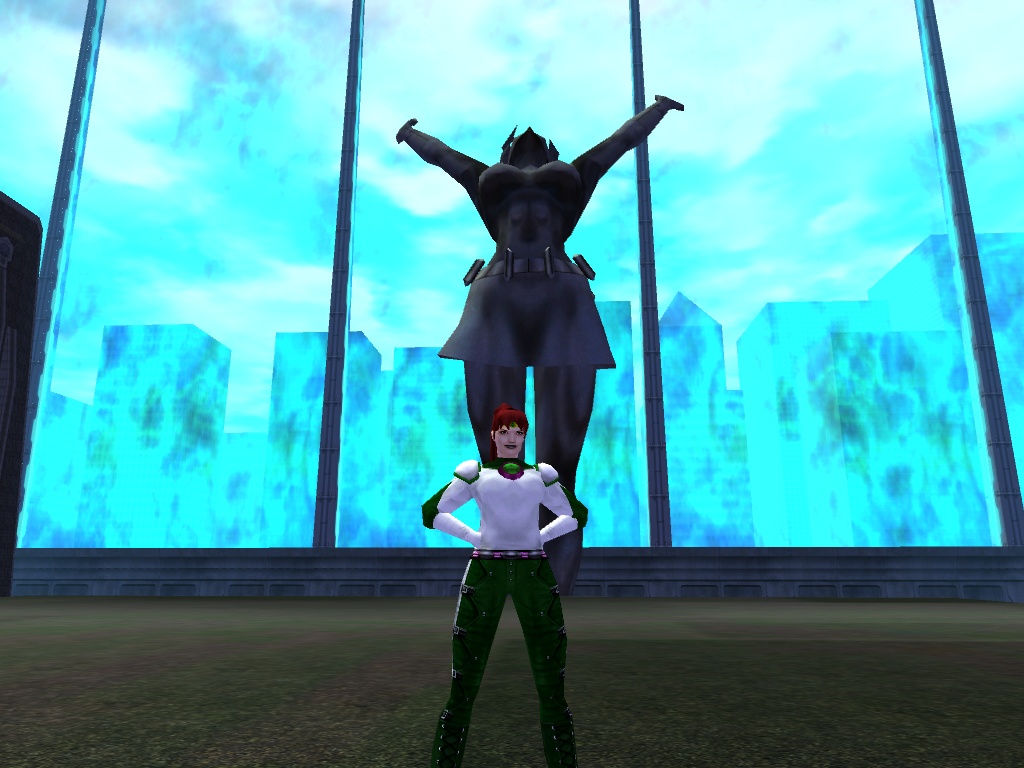
New heroes emerging from the tutorial could (until quite late) start in Atlas Park or Galaxy City; since Atlas was first on the list, most people picked it, and Atlas was often full of what might politely be termed "merry chatter". I always started in Galaxy (until a later content release wiped it away), and here's Thunderforce in her first stomping ground. The giant statue of Galaxy Girl was a popular haunt for roleplayers before City of Villains and the joint hero/villain hangout Pocket D. (Anyone remember the Paragon Dance Party? I do.)
Doctor Bowman always thought her research into remote cell manipulation at the Philippa Fawcett Nuclear Research Institute was purely academic - until two heroes died defending the Institute from a Hellion raid. She resolved to perfect her techniques and use them to aid other heroes in the struggle against the gangs that plague the city; however, she still doesn't understand the compulsion to wear spandex tights while doing so. She dislikes the sobriquet "Pressure" forced on her by the newspapers and prefers you address her as "Dr Bowman".
Pressure was second; I was still very green, and decided to make an empath. Not all defenders are healers, but if any kind of defender is, it's empaths. Not only that, but empathy is absolutely full of premium power selections - a hidden advantage to some powersets was that all the really good stuff was in a subset of the powers, leaving you free to make more selections from your secondary set or from the "power pools". With empathy, if you were going to take a travel power and its prerequisite, and get the exceptional Stamina power at level 20 (later Stamina and its pre-requisites became inherent powers, giving much more character freedom in the early levels), you weren't touching your secondary at all, unless you ignored Absorb Pain - and that means solo missions take a very long time with your one attack. (Later, the game addressed this effectively with alternative builds - one for teaming, and one for soloing (with attacks instead of powers that help others), in Pressure's case.)
Absorb Pain divided players. It cost almost no endurance and healed a gigantic amount even without enhancement slots devoted to it. The downside? It damaged the user, and blocked them from healing by almost any means for a few seconds. Most of my memories of nervous moments with Pressure involve Absorb Pain; you let it off in an emergency, or when you're dry on endurance, but now you have to be very careful to stay alive with no way to heal yourself... and if things are going that badly wrong, pretty soon you're going to want Absorb Pain again. Naturally, you can't use it on yourself.
I remember two moments of glory. A Synapse task force that finished with three heroes fighting the Clockwork King arch-villain - or, at any rate, two fighting him and one pulling out all the stops to keep them in the green, health-wise. He took forever to take down, and I spent half of it popping Absorb Pain and hiding behind things. The other was a Terra Volta respec trial, which worked out much the same way except with six heroes and approximately a million Sky Raiders. Drop Absorb Pain and at least you can hide from the Clockwork King - but with a vast horde of high-tech mercenaries zipping about, someone's going to be beating on you - but if you're out of endurance and the tanker's nearly dead, you've got no other choice. Did I mention there's a reactor in the room to protect, so there's no prospect of running away and regrouping? I honestly have no idea how we made it through that.
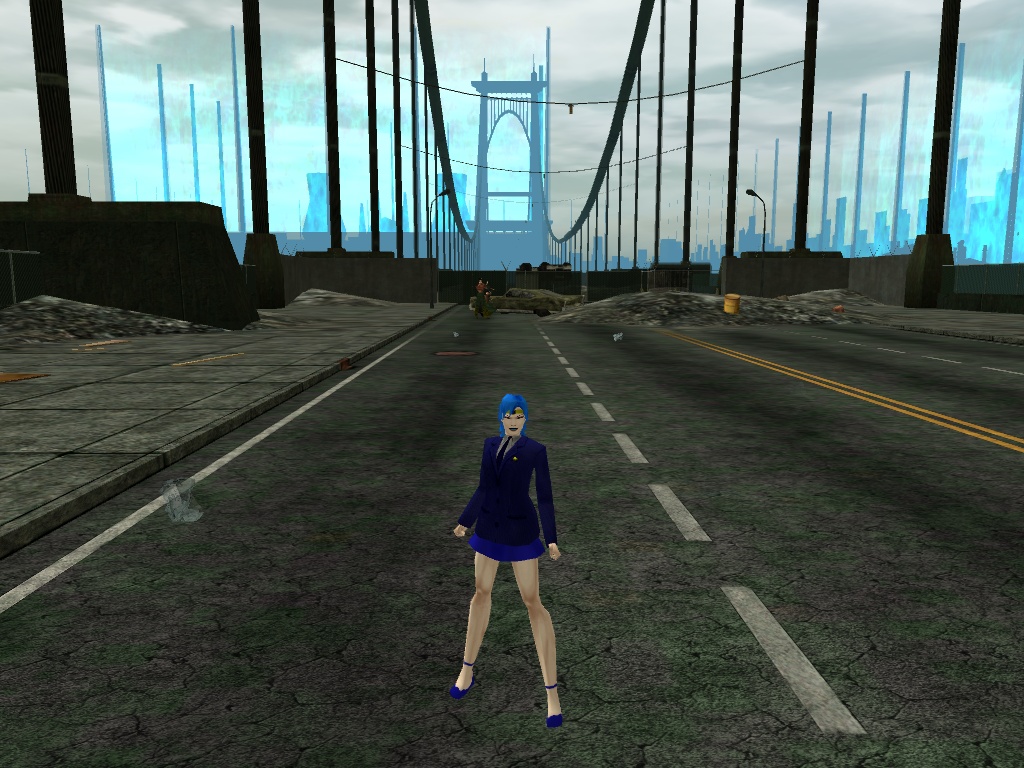
Pressure's short and slight, relatively sensibly dressed, and (with the introduction of body scaling) as realistically proportioned as you can be in a game about superheroes. She's also secretly Sailor Mercury, but I stopped doing that after her. Here we're in Independence Port, a relatively giant zone, with the Terra Volta reactor behind her.
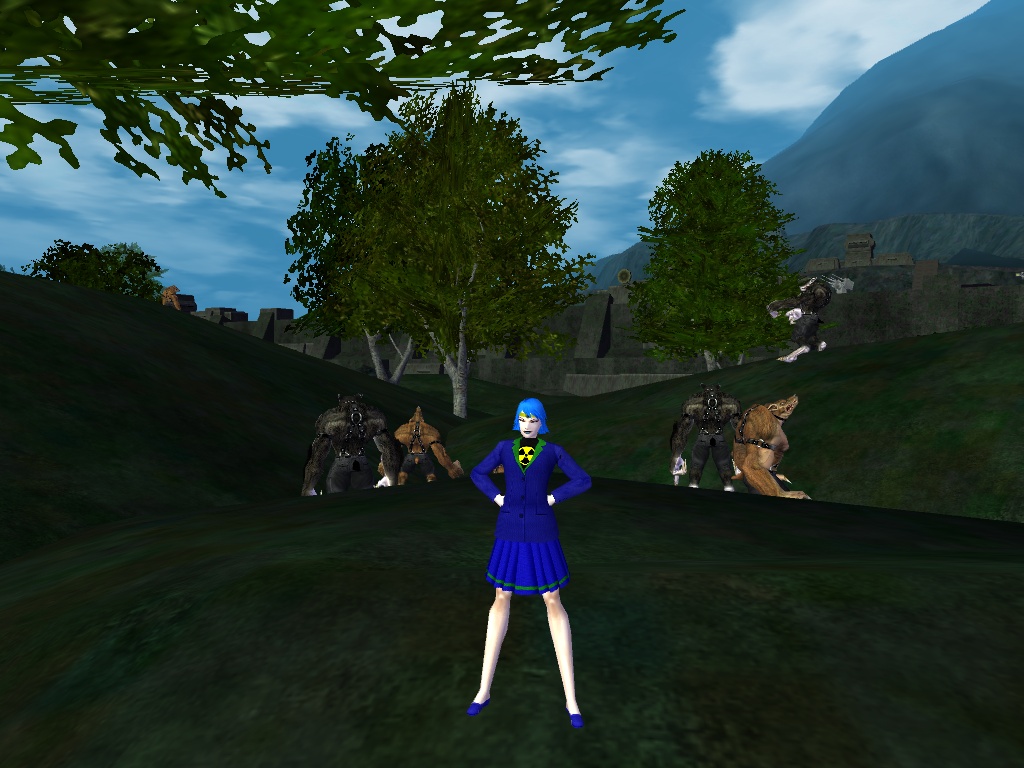
Sensibly dressed, except my dear occasional teammate Jookulah would tease me about her wearing a schoolgirl outfit; so I resolved that her second costume should be one, to settle the point that her first costume was not. I think that made sense at the time. We're on Striga Isle here, a location with some good story arcs, looking back at the fortress of the fascist Council - and their very big dogs.
At age 23 Carol Bowman was just a tough punk; after her third conviction for assault she was kidnapped en route to the state prison by the 5th Column seeking suitable women for a super-soldier breeding programme. She underwent extensive genetic manipulation and augmentation surgery; the experiments killed many of the captives, but in her case it was successful; so successful she overcame her captors and escaped with inhuman strength and resilience. She is now dedicated to pursuing and overthrowing the 5th Column.
And an Invulnerabilty tanker, who's also one of the classic trinity, ahem. I had more fun with her costumes than anything else; I don't have much to say about her, really. Got the job done, especially once dual-builds meant I didn't have to compromise between defences for teaming and offence for soloing, but the nature of being a tanker means that if things don't go hideously wrong, you just keep taunting enemies and punching big scary-looking ones. She didn't get to a high enough level that Invulnerability's weakness to psionic attack was an issue.
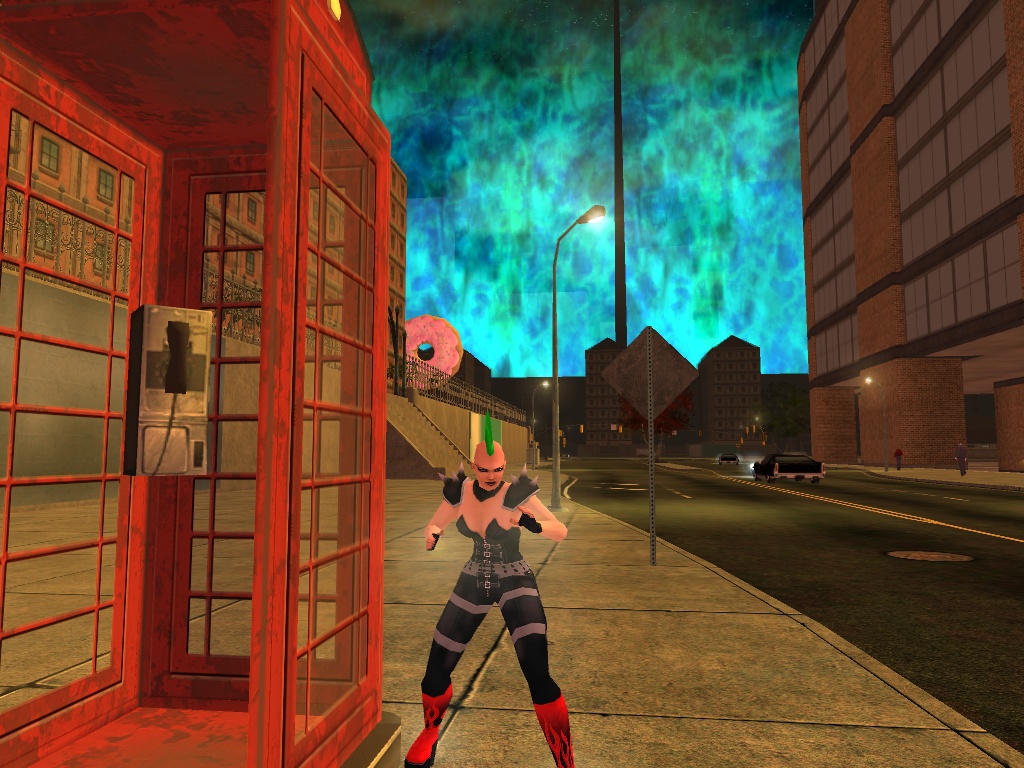
Faultline was a fairly pointless "ruined" zone like Boomtown, all holes to fall down and no reason to go there; but a later update reworked it with new construction at one end, fallen skyscrapers in the water in the middle, underground tunnels, a dam, and its own mission arc which was pretty good fun (albeit chock full of Elite Bosses, which was a nuisance if you were poor Pressure solo). I don't know why it has London phone boxes in.
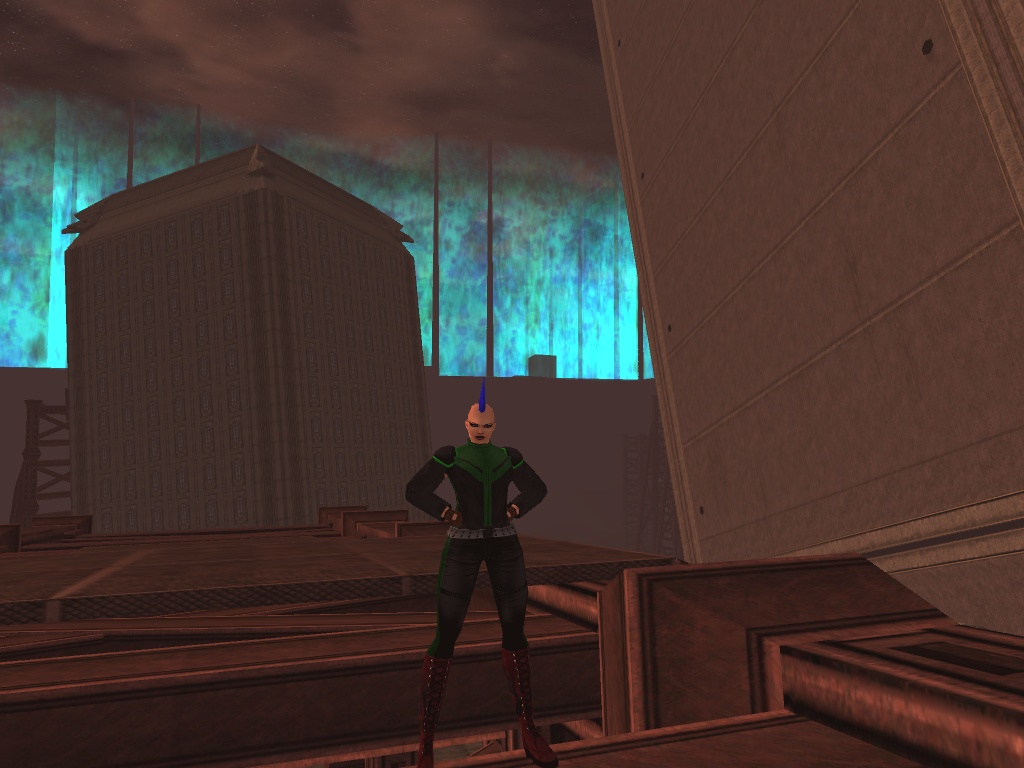
I'd sometimes get several missions into a team before someone noticed her mohawk kept changing colour, at least until I got her third costume, which is hard to miss. We're still in Faultline here, but looking out over the wrecked area.
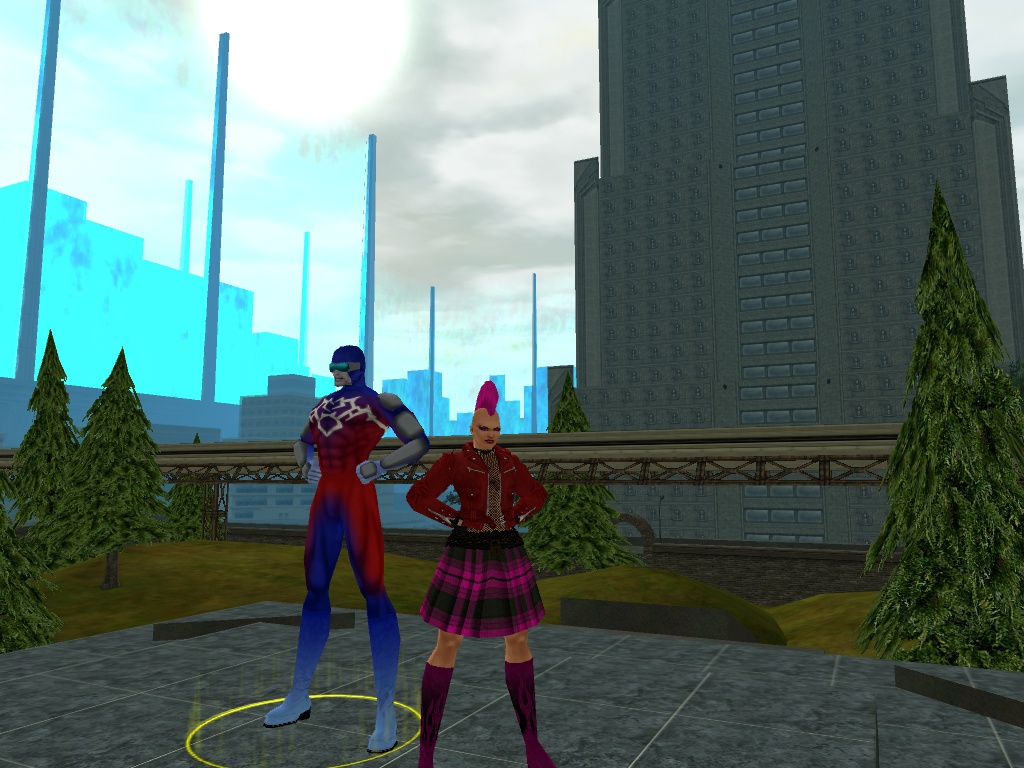
Most of Skyway City is run-down under huge flyovers, but there's a little park, and here Synapse gives out the second task force.
Susan Bowman had long suspected she might be a superhero. Her sisters' awesome mental powers, incredible strength, and nigh-invulnerability were all pointers, as was her parents' dedicated worship of Nyarlathotep and persual of the Book of Eibon. In view of these facts, she was not entirely surprised when her own powers manifested.
I could never quite decide if I preferred to write silly character descriptions or sensible ones.
Zakuko was a blaster, which we expect is going to complete the trinity, but there's a twist; "blapping". Most blaster primary powersets are comprised of long-range attacks, with a mix of single and multiple target options, and perhaps one short-range extra-power zap; most blaster secondaries have some very effective melee range attacks and some utility powers like Build Up (boosts damage massively for a few seconds). There are oddities like Trick Arrow and Devices, but that's more or less how it works out, and the general idea is that you hammer away with long-range attacks, use multiple target attacks once you're confident the enemies are concentrating on other heroes, and save the melee attacks for emergencies.
A "blapper" takes the opposite approach. Aside from the slight issue of counterattacks, the melee attacks are best; strongest and cheapest. Take a primary like Energy Blast which has a really good short-range extra-power attack, Power Burst; take a secondary like Energy Manipulation that's got solid melee attacks - Energy Punch, Stun, and the superlative Bone Smasher. Manage enemy aggression not by staying out of range but by concentrating on single-target attacks, so you only anger one enemy at once (in a team); and dispatch them at point-blank range with overwhelming force. Blappers team very well with defenders that mitigate incoming damage (when it goes wrong, you'll be dead before an empath can heal you, but Sonic or Force Field bubbles protect you in advance) and superbly with Kinetics (who push out healing auras from the enemies and auras that boost damage further, and tend also to be close to the action.
Zak was so much fun, I never really played any other kind of blaster. Charge into the fight just behind the melee types (occasionally in front, when extra impulsive); pick my victim, Build Up, and hammer them down with the Bone Smasher. Select another victim - well, by select I mean to "scrapper-lock" onto the nearest likely lad, quite oblivious to the overall situation. Death or glory! Surprisingly, if you're disciplined about only attacking something you propose to kill, it works rather well - as we used to say, "death is the ultimate debuff", meaning that one way to stop the bad guys hurting you is to defeat them as quickly as possible.
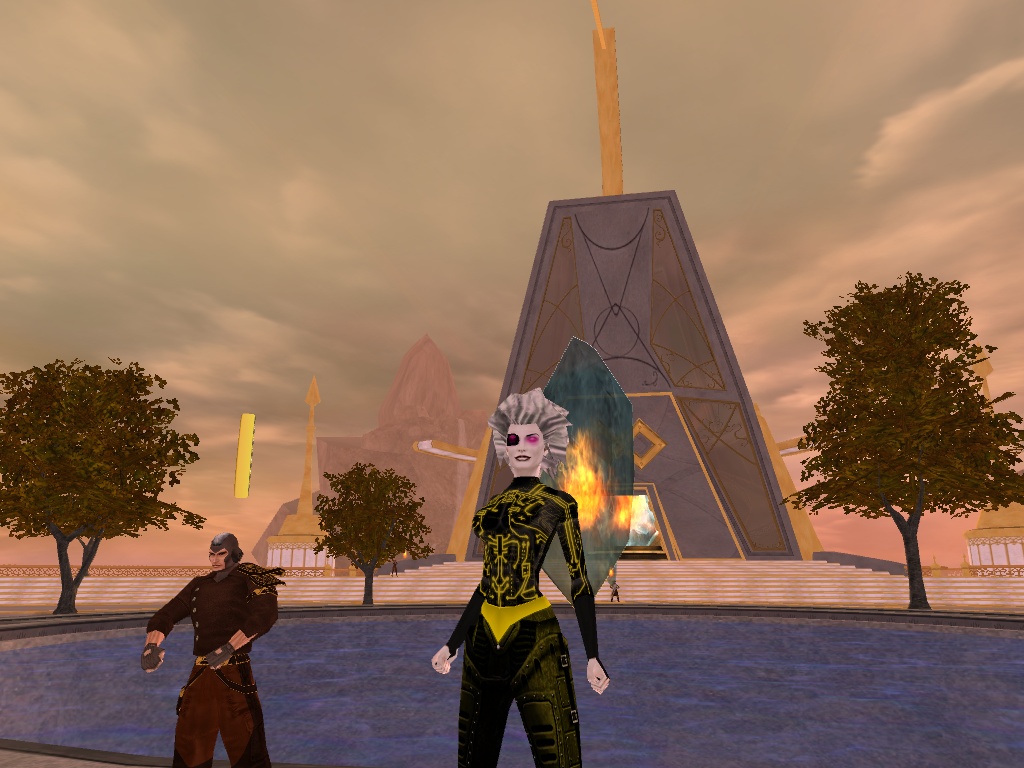
Zakuko is very, very tall. Her freakish appearance got a lot of comments. We're in Ouroboros, which had a sort of time-travel backstory, but its real purpose was to improve the game with Flashbacks - through Ouro, you could go and do any content you'd outlevelled, or visit "obsolete" versions of zones like the pre-disaster Galaxy City. Before Ouro and the no-XP option were available, in extreme cases people would farm experience debt to avoid unwanted levelling past content they wanted to run. It's because of Ouro that Thunderforce eventually did every single story arc in the main game. It also acted as a convenient way to travel to various city zones - part of the way you did more missions and less moving in later issues.
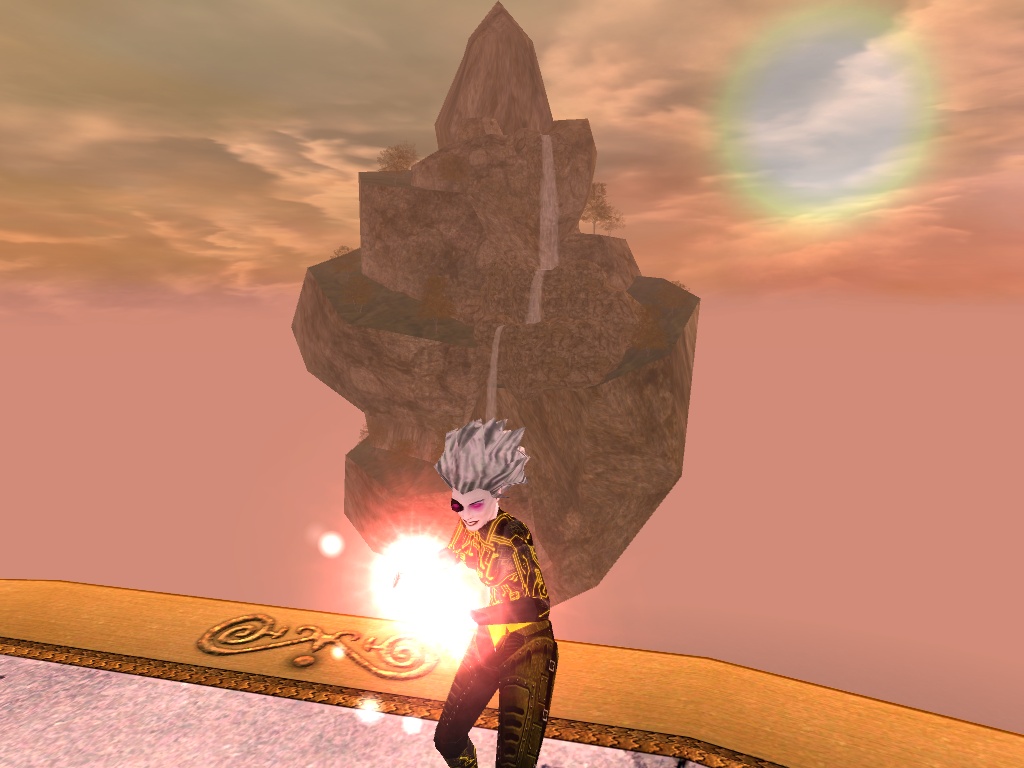
The Energy Manipulation "pom-poms of death" were the last thing a great many villains saw, I'll warrant. We're at the back of Ouro, hovering rocks behind us, with the Bone Smasher ready to go.
Being a superhero's great. Being a superhero's little sister? Not so hot. What you really need, at school, is for your big sister Susan to be on the evening news wearing 3 square inches of spandex. Whatever happened to secret identities? Worse yet, you look like her, only she's tall and striking with bone-white skin. You're short and ordinary - also with bone-white skin, which makes you look like an accident in a whitewash factory. And, come puberty, of course your superpowers manifest... guess what, Elizabeth Bowman? You've got the same superpowers as your big sister, only they're not as good. She's saving the world; you're saving handbags. You wear a mask in the vain hope no-one will figure out it's you - the skin really helps with that. At least, unlike Susan, you have the wit to defend justice with less revealing clothes on.
I liked Zakuko so much... but I liked her more at low levels. I think she stalled somewhere in the 30s, about the time when everyone was Inventioned out and area effects were becoming better and better ways to dispose of enemies. Eventually, I gave up and wrote her little sister - additionally, offering me the opportunity to go through the low levels knowing already I was going to be a straight-up blapper, where with Zakuko I hadn't really settled on that.
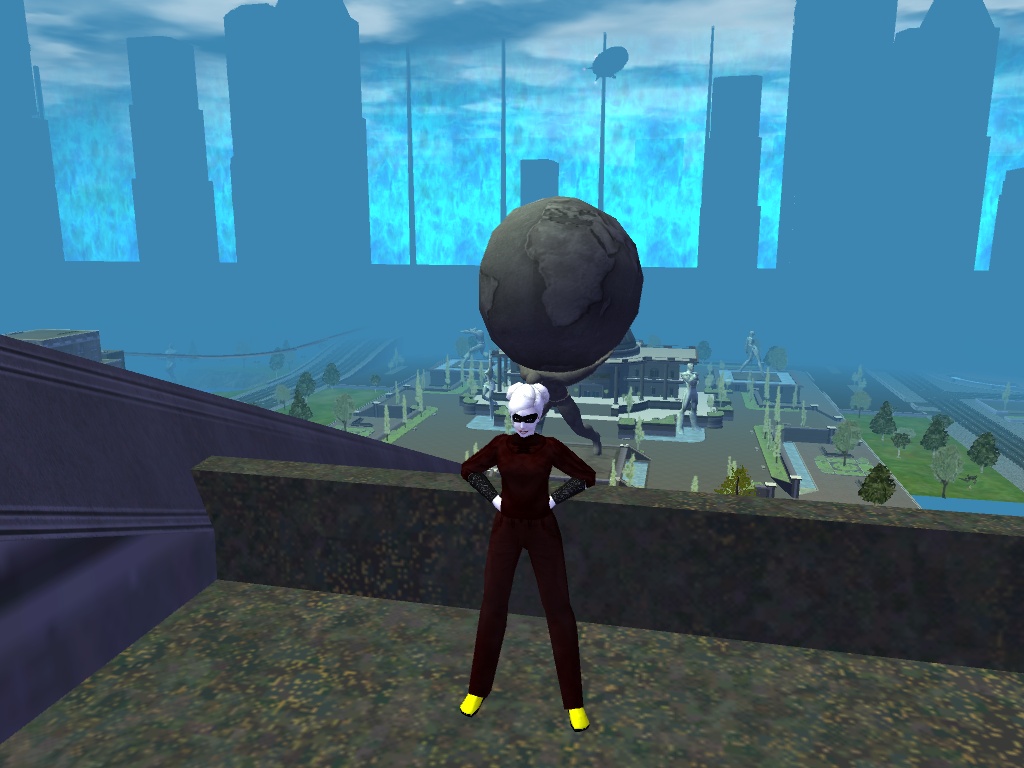
Here we're in Atlas Park, the other newbie zone. There's the giant statue of Atlas (superhero, not mythical figure) and City Hall, where most of the merry chatter takes place. I'm pleased with her design; like someone who can't deny that she is a superhero, but doesn't have to like it.
Jaguya Bowman was deliberately exposed in childhood to high levels of metastable radiation in experiments intended to induce pyrokinetic abilities in humans. She escaped - her captors had omitted to consider the full ramifications of success, a fatal mistake when dealing with an rebellious adolescent who can set people on fire - and made her way to Paragon City, where she seeks to explore the full range of her powers. She has already discovered force manipulation abilities her creators never dreamed of.
A controller, the only one I ever really got anywhere with. Like many characters, she was greatly improved by team vs solo builds - and by the addition of "Containment", a controller inherent power to do double damage to enemies already held/stunned/etc... which is not so much huge damage as slightly faster nibbling-to-death, but helped with soloing. She wasn't helped at all by the giant controller nerf early - but controllers were absurd before that; on one occasion I and another fire controller got separated from our 8-man team, so we just locked down a vast horde of enemies indefinitely and waited for the other six to find us - after the nerf you could lock down plenty of people, but not hold them down indefinitely, so you were dependent on good team tactics to take them out while they were locked down. The downside came when you popped your best hold or stun and your team stood around looking dappy rather than attacking.
I went with Force Fields for her secondary. In my view there were two approaches to controller secondaries (which were the same sets as defender primaries); one was to take a set like Kinetics with lots of good stuff, but then you'd end up using it all the time - worst case as an Empathy controller, you want all nine powers (except maybe Absorb Pain) and all your attention and endurance will go on them, in which case you should probably have been a defender.
The other is to pick a set which, while not useless, demands a minimum of power selections, slots, attention, and endurance. Force Fields has four really desirable powers; one for emergencies, one big bubble you leave on and forget about, and two bubbles to stick on each teammate once every four minutes. The result is that you get to do a lot more controlling, with more powers, time, and endurance to hand. The emergency power renders you virtually invulnerable, too, which means that coupled with Recall Friend (a teleport power) you can often sneak through missions that don't require you to defeat every enemy - or escape a disaster and recall your allies' corpses for resurrection in a safe place.
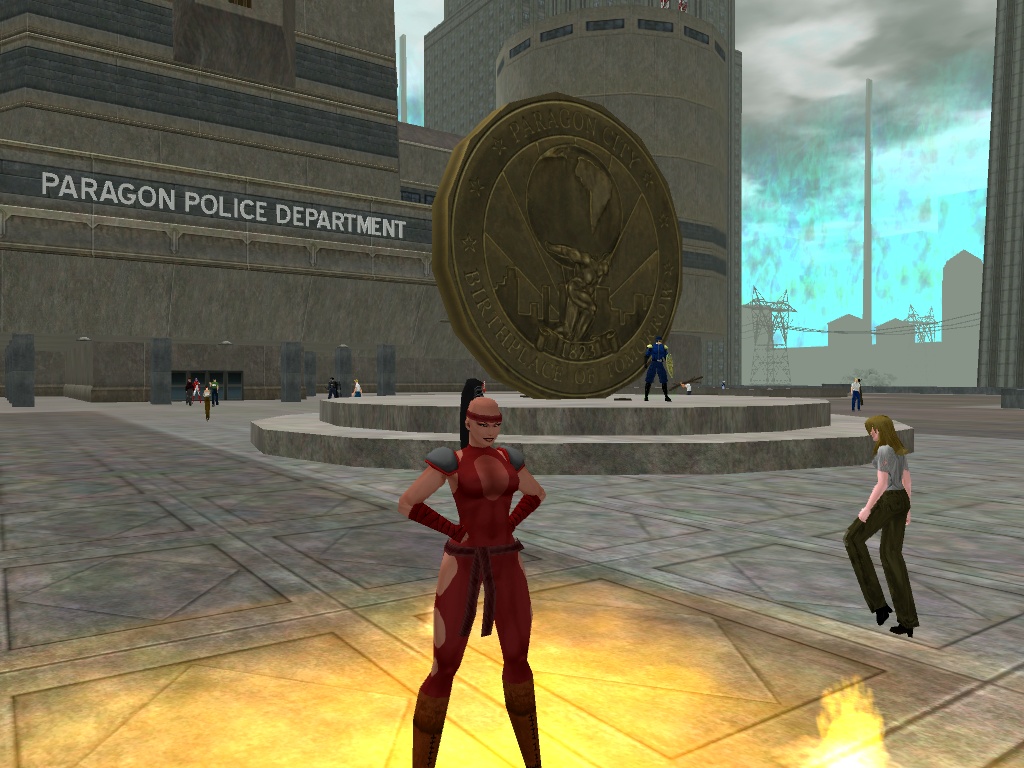
This is the large Police Department building in Kings Row, a very run-down industrial area. Earlier in the game, you'd keep getting missions to kill Circle of Thorns (dead sorcerors possessing the bodies of the living) in King's Row... where they appeared only at night, and hid on top of skyscrapers which (unless you had the Fly prerequisite Hover) meant a lot of climbing up fire escapes hopefully. Thankfully, that got addressed in later issues... but between that and their blasted Ruin Mages, I'd pretty well always kill Circle of Thorns given a chance.
The Red Flag is the product of a USSR project to produce a robotic super-soldier intended both for conventional military use and to battle enemy supers; fast, strong, practically impervious to conventional weapons, and with a complete self-repair capability. The project was a technical triumph, but the resulting robots were prohibitively expensive and never saw frontline use. After the fall of the Soviet Union, the remaining prototypes were lost or sold on the black market. Unit 23 was obtained by an Arachnos research division; now that study of the robot is complete, the intention is to recoup more of the purchase price by using the robot to carry out combat assignments. However, the Red Flag's advanced positronic AI has struggled towards self-awareness, and it is increasingly prone to pursue its own objectives - whatever they may be.
Not my first villain, but the only one I really got very far into - I didn't really find villainy as satisfying, although I was absolutely delighted to find that the name "Red Flag" had not gone. This is also a rework of an earlier Red Flag - into the electrical defence set that was a good match with concept and design, and into Energy Melee because, well, the Bone Smasher.
He's a "brute", a sort of middle-ground between scrapper and tanker. The odd thing about brutes is their attacks start anaemic and build up damage the more they attack or are attacked (with "Fury" then draining away over time), so brutes tend to like to rush from one fight to the next with full Fury bars. This does not always make them popular with their teammates. This was originally a villainous class just as the others were heroic, but later not only could one "go rogue" from villainy to heroism and back again, but one could start any class on either side. I'm not convinced that was a good idea; teaming "redside", with one set of classes, used to have a very different feel to heroic "blueside".
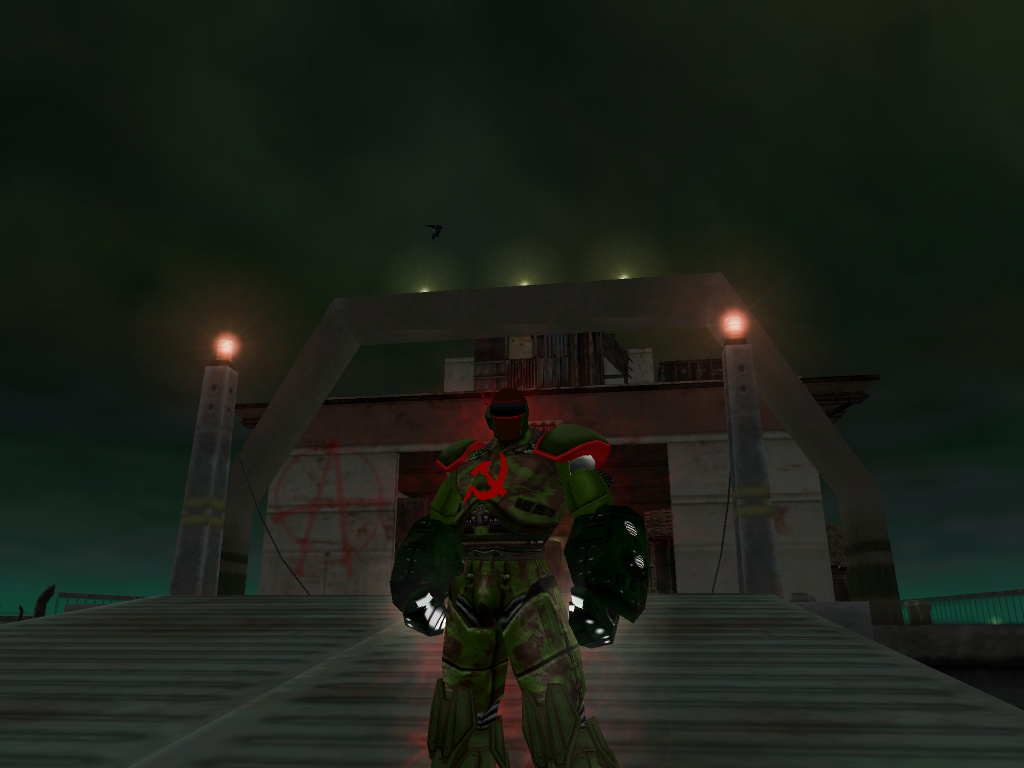
This is the first screenshot whose location isn't obvious - the Rogue Isles are full of these slightly run-down ferries, and also I'm a lot less familiar with them. He's got the Male Huge bodytype, a good fit with his design.
Many years have passed since Julia Bowman donned this suit of oddly engraved armour. Something like her voice still speaks from it; but whether she is truly alive within is quite unknown. It is clear that it is the armour and not the body which seeks to destroy all that threatens Paragon City.
A broadsword / invulnerability scrapper, created to try and figure out if Thunderforce's approach really was the best. Notwithstanding the immense damage broadsword dishes out (the attacks are correspondingly slower, but that still means fights are more "what to use next" and less "spam kicks in all directions"), I wasn't totally convinced - and if the game was still running, I'd do my utmost to make any new scrapper concept fit Willpower.
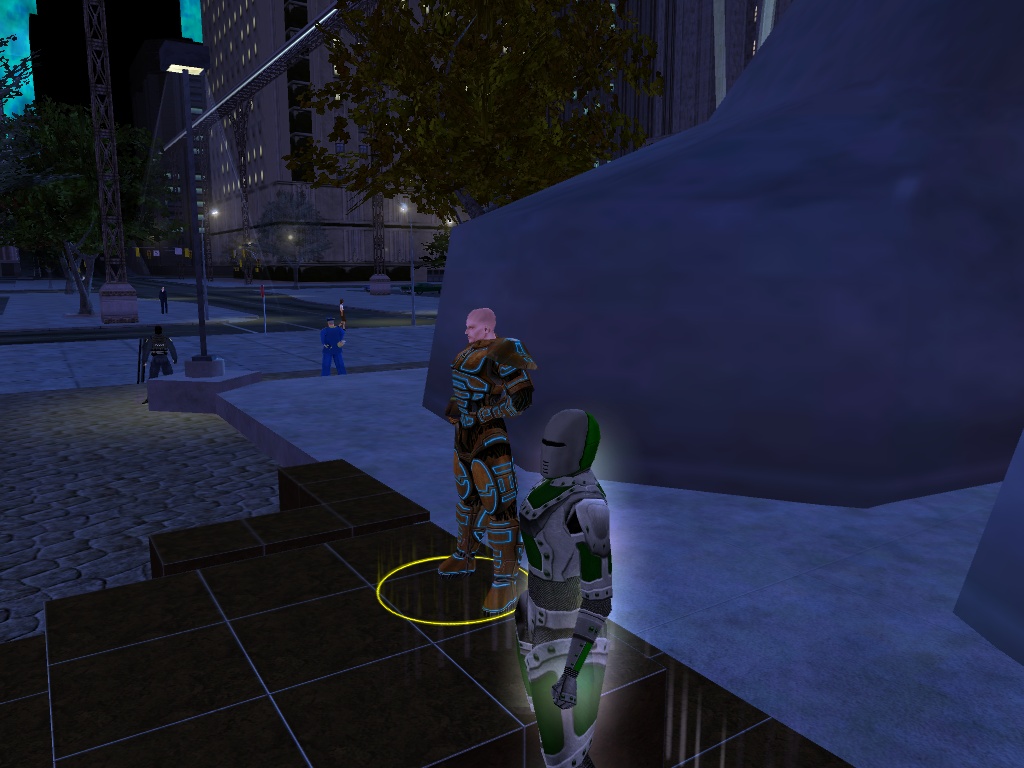
Steel Canyon used to be the transfer point between the two monorail lines before travel got easier, meaning that you'd travel the length of it many times - fortunately, it had nice straight north-south roads between its massive skyscrapers, making life easy for all but Super Speed characters (whose lack of vertical mobility was a curse in a zone you didn't know well, before the universal availability of cheap jetpacks; Super Speed's prerequisite Hasten was marvellous for some classes and powers, or no-one would ever have used it).
That's Positron behind me; I think I have mostly forgiven him for his meat-grinder of a taskforce.
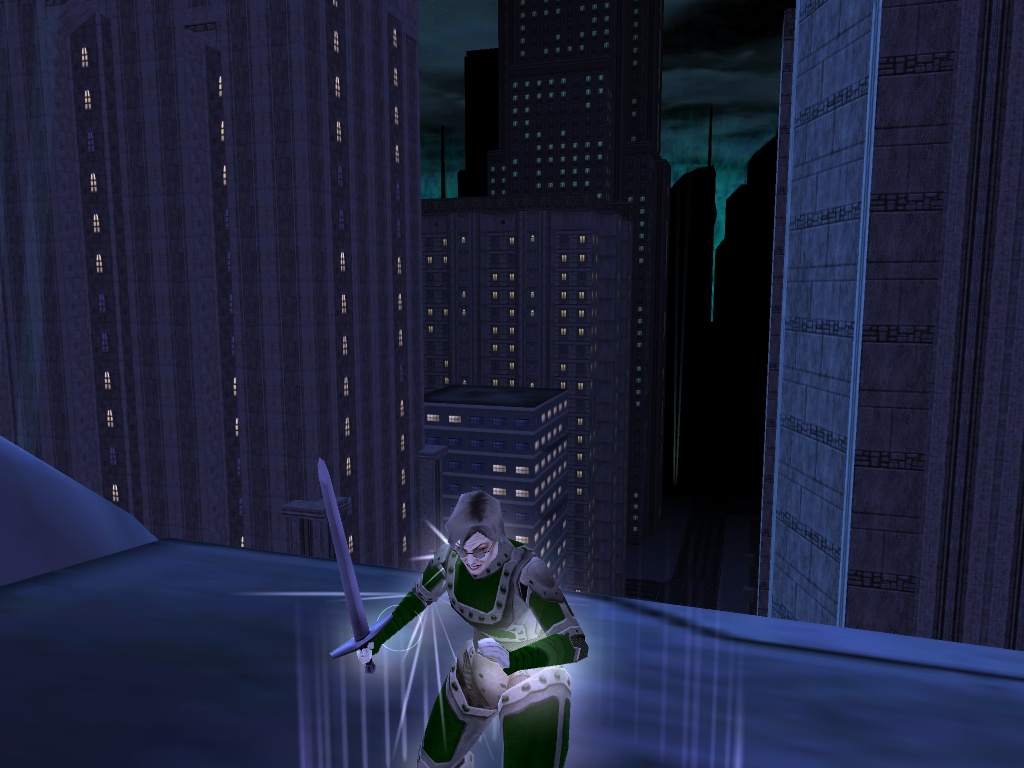
This costume for Necessity is obviously non-canonical - no-one has seen her face. But if she did take her helmet off, that's how she'd look. We're atop the statue that the last picture was taken at the base of.
Hails from the frozen North. Parents ate at a radioactive Tim Hortons, sort of thing. There comes a point where one's character design dictates a ludicrous origin story, and this is it.
My silliest concept, but one of my more serious characters; a Force Field defender. If Force Fields leaves controllers free to control, it also leaves a defender free to take and use Leadership powers (which eat endurance, but boost allies' damage, defences, etc) and to plug away with her popgun secondary. Why bother? If the secondary is Psionics (originally defender-only) where most of the attacks carry a controller-like stun or knockdown - as well as defending the team with bubbles, you can defend it by making a nuisance of yourself to the enemies. I created her as a complete change of pace from Pressure - instead of the fixation on the two square inches of screen covered in health bars, you drop your bubbles on people, try and stand somewhere useful for your Leadership auras and the bubble extending from you, and look for victims. Another use for the popgun attacks is to spot enemies who are nearly dead but not under attack, and polish them off.
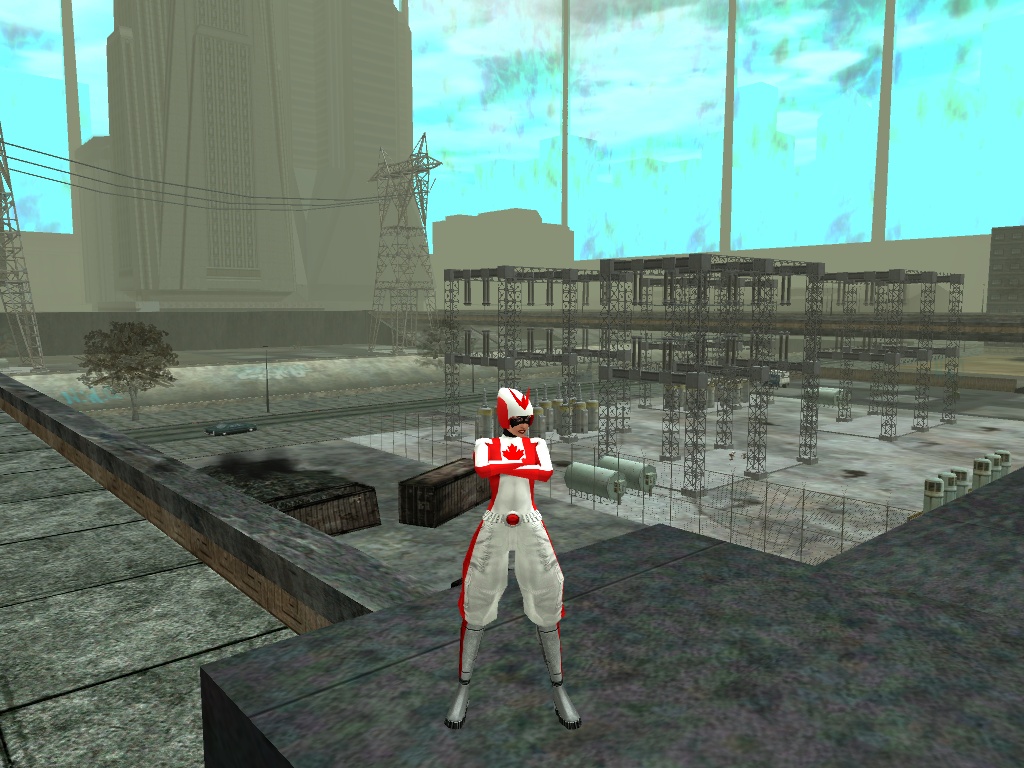
Appropriately enough, Kings Row is replete with Clockwork, little psionically controlled semi-steampunk robots. Their vulnerability to psi damage means also that Toronto's popguns were actually fairly effective.
Lucy Bowman - The Scamp - has stolen an experimental pyrokinetic array from the Phillippa Fawcett Research Institute. Naughty of her, but the Institute sees this as the ideal opportunity to collect research data on the array without any adverse consequences if the user should be unfortunately incinerated.
Another silly bio, albeit I rather like her design. Fire tanker, to see what that was like, but I tend to feel it was neither fish nor fowl once it stopped being overpowering. Need I add her secondary has the Bone Smasher in?
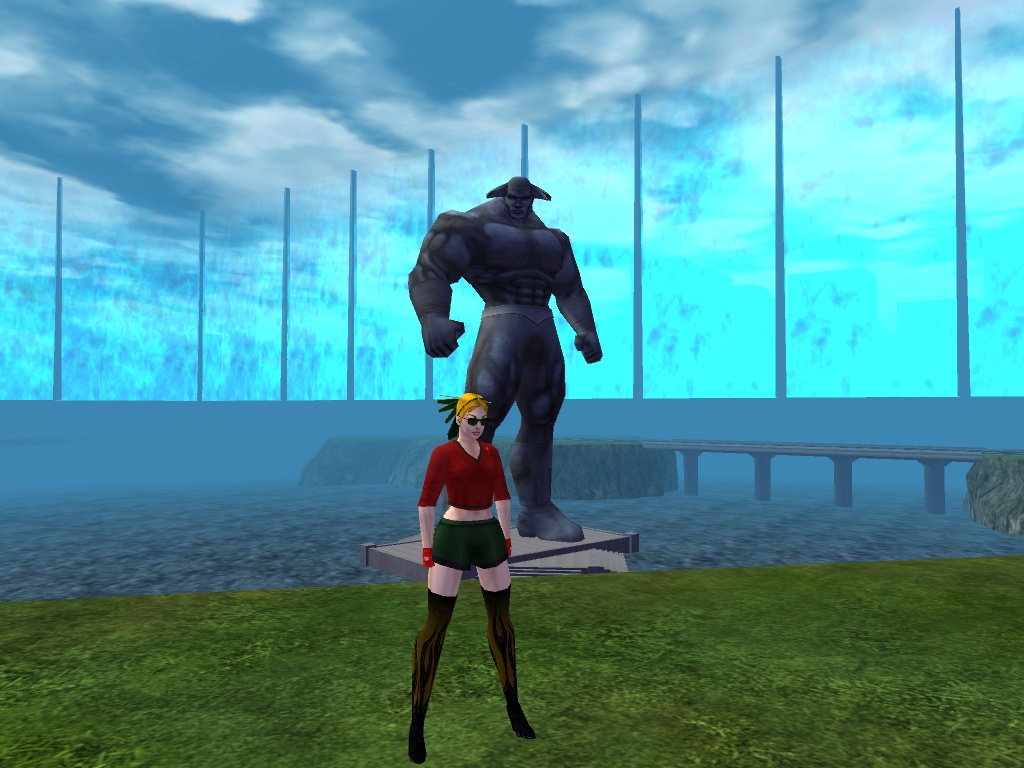
Talos was when you'd arrived; level 20, with Stamina (before you got it automatically), the first zone just on the high-level monorail (before the two monorails merged), and nice and compact and easy to get around (unlike the comparably-levelled Independence Port, a huge zone). Talos led to Striga Isle, one of my favourite zones, with the Council's fascists and Banished Pantheon zombies; it's got more interesting enemy groups like the Devouring Earth and the Freakshow (pity about the Warriors, but nothing's perfect) and contacts with solid missions. Get to Talos, the character's matured; and here we are looking out from the shore.
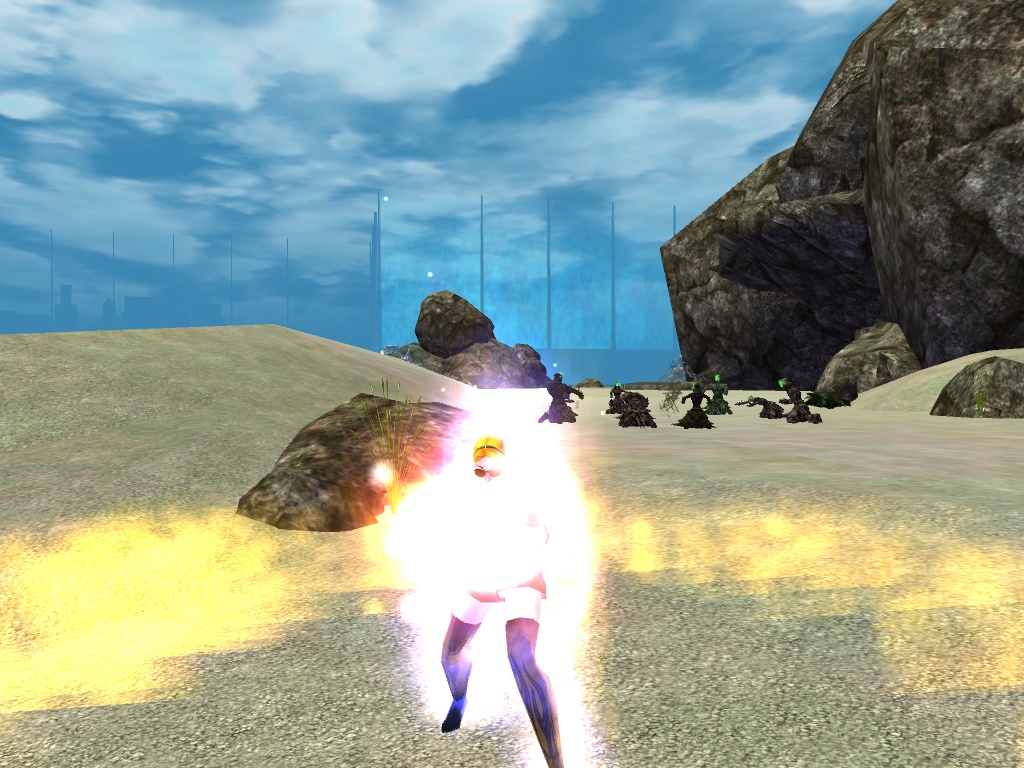
The trouble with being a fire tanker is you will basically never see your costume in-mission. Talos had a lot of little islands out in the water, and we're on one of them.
Doctor Andrew Jameson has never doubted Emperor Cole's vision and authority. "Praetoria is unquestionably under constant threat and to confront that threat means all must join together for the common good." That used to mean quiet research, developing autonomous support robots under Professor Sarah Fawcett at the Ministry of Technology. However, recent breakthroughs in his work have resulted in his assignment to the Powers Division for field work. He seeks order; to lead by example or to impose it by force if need be, opposing all those who would sink the world into chaos. He is unfazed by his new assignment, with the courage of his convictions behind him.
Last but not least. In the original City of Heroes canon, the Praetorian universe was a straight-up "evil mirror", probably with goatees and jackboots and all; each "signature hero" had a corresponding Praetorian arch-villain to fight. This started to look a bit odd with the release of City of Villains - are the Praetorians the ultimate evil, or is Lord Recluse's Arachnos? (Or maybe is Statesman's other evil twin Reichsman the ultimate evil, now he's back?)
Going Rogue retconned that pretty heavily, albeit the Praetorians are still not nice chaps; Praetoria is a police state, but possibly a necessary evil given its embattled position in a world otherwise consumed by the all-devouring Hamidon. The Praetorian Loyalists do terrible things to support the system, but the Praetorian Resistance do equally terrible things to pull it down - with arguably the Responsibility faction of the Loyalists closer to the Wardens of the Resistance than their own extreme wings. Game mechanically, a Praetorian character chose one faction, with missions available from either subfaction, with "moral choice" missions letting one switch... and with opportunities to go undercover. Praetorians eventually emerged at level 20, picking one of Hero or Villain - if the game had not been killed, we'd have seen an option to stay in Praetoria.
This seemed like a pretty interesting deal, especially since the standard of writing on CoX had generally improved during the game's lifespan. Dr Jameson was mostly solo - a mastermind, an originally- villainous class that summoned minions to fight through missions, aiding them with defender-like powers; and ideal for soloing if one can tolerate their somewhat slow pace. However, in spite of that, he was one of the more roleplaying-ish characters; his bio clearly establishes his personality, and I found myself thinking his thoughts as I ran through the Praetorian stories.
I spent my last couple of hours on CoX before the final black dawn finishing off the Praetorian arcs and getting Dr Jameson out into Primal Earth, and I'm glad I did, going to Atlas Park with Thunderforce with perhaps 45 minutes to spare.
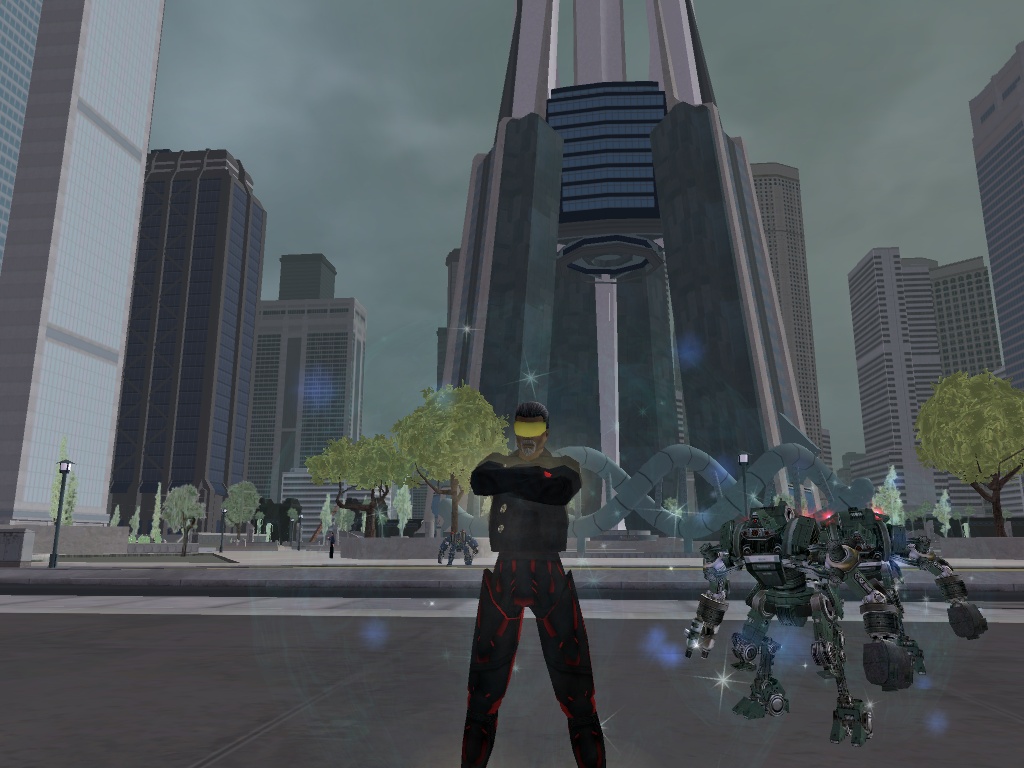
His costume's intended to suggest the uniform of an authoritarian state; as Loyalist Praetorians go, he's not too bad, but that is not saying a great deal. The background is typical of Praetoria's architecture.